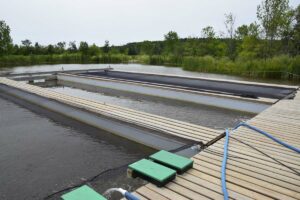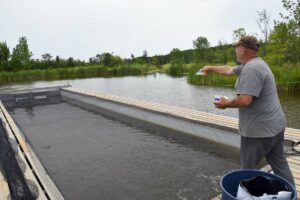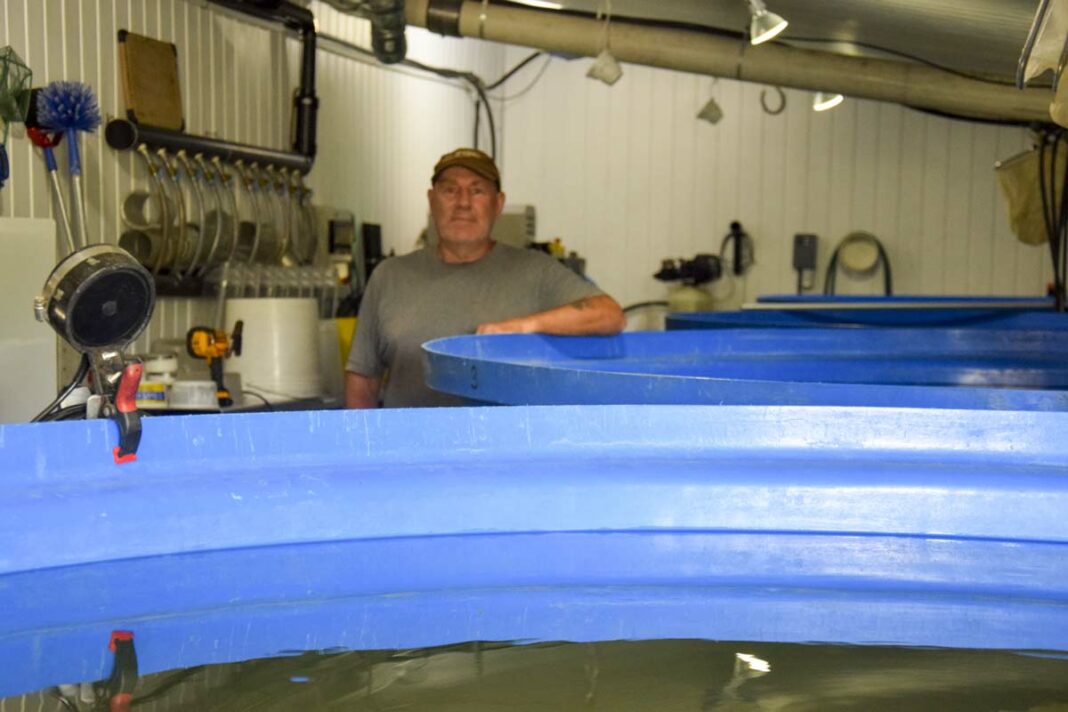Manitowaning entrepreneur now shipping rainbow trout
ASSIGINACK—John Caselton is something of a modern renaissance man—accomplished musician, sometime snow plough operator and inveterate inventor, but his true passion is fish, or rather the efficient raising of same. His land-based aquaculture operation located off Highway 6, just outside Manitowaning (behind/beside the Service Ontario office run by his wife Colleen), has attracted interest from a host of government agencies and educational institutions.
Mr. Caselton has been researching the land-based raising of fish—rainbow trout, bass, whitefish and walley—for over a decade now, and he has discovered a great deal from his hands-on operation. It only takes a moment of conversation with the inventive aquaculturalist to discover that his is more of a passion than a vocation.
“How do you make a small fortune in aquaculture—you start out with large fortune,” he quips. Mr. Caselton has invested in his operation and some has come through various grants—and, of course, the sale of fish. He recently shipped 88,000 rainbow trout fingerlings.
The Expositor interviewed Mr. Caselton several years ago, when his operation was much smaller, the indoor tanks stainless steel tanks a fraction of the size of the massive plastic ones he utilizes today. Mr. Caselton generously welcomed the paper on a recent tour of his much-expanded operation—some of which can be seen from the highway. Unfortunately, the sheer volume of would-be kibitzers dropping in unannounced has forced him to chain the drive into his operation when the Service Ontario office is closed.
We start out in the closed-circuit hatchery, where water is pumped through large pipes from tank to tank, utilizing the science of water columns properties and micron-sized screens to remove sediments and fish excrement that eventually wind up in a churning tank where chemical reactions change ammonia and nitrous components into nitrates—essentially a valuable fertilizer that Mr. Caselton one day hopes will drive an agricultural component to his system.
He notes that an operation in a defunct brewery started out raising tilapia for local markets and added an offshoot raising salad greens. That offshoot proved so successful they stopped selling the tilapia and now just keep them to produce the fertilizer, he said. But that is well down the line. Mr. Caselton has plenty of other balls in the air occupying his time learning about the care and handling of fish—there is a lot yet to discover, he assures us.
In the meantime, his closed system indoor hatchery only loses about one percent of its input water during operations, with evaporation and the inevitable spray taking their tiny toll. The operation, which involves a tremendous amount of the pumping water between the closed-system inside hatchery tanks and between the outside ponds where the fish are raised to their saleable sizes, is surprisingly light on energy consumption—the result of Mr. Caselton’s detailed research and development.

By utilizing the science of aqua dynamics, for example employing pumps that utilize air pressure to lift, rather than pull water up, the energy required is reduced dramatically. It’s tremendously important to keep an eye on these details, as literally hundreds of thousands of gallons of water (180 gallons a minute) need to be on the move constantly in order to maintain a clean and healthy environment for the fish and to ensure the operations byproducts are converted efficiently into safer, and useable forms.
The axial flow pumps use propellers within the pipe shaft of the pump to move the water in the tank, providing high flow with low head pressure which, in turn, flows through a nozzle to create a clockwise current around the tank, creating centrifugal force that moves any excess food or effluent to the centre, where it is collected through a system, one he designed himself.
Water flows through different size pipes to maintain the proper velocity, travelling to a drum filter that separates the particles out, utilizing a radar sensor to indicate when the screen needs to be cleaned off by a spray nozzle. By the time it reaches the final tank, a biological filter, the solids have nearly all been removed. “It’s mostly ammonia and other things toxic to fish—ammonia being the key,” said Mr. Caselton. “K1 media (no it’s not macaroni, although it does look a lot like it),” he said. That substrate is comprised of two types of bacteria, one that changes the ammonia into nitrites and then another that changes the nitrites into nitrates. “That’s the nitrogen cycle,” he said. “Flow and temperature plays a role in how this works, the bacteria are called chemotrophic bacteria, so you are trying to breed those bacteria.” It is also important to remove the organic matter, otherwise the ammonia couldn’t be removed.
The water is cleaned by that point and is sent back to the beginning of the system. The operation is 99.97 percent recirculation—creating an almost completely closed system.
A lot of factors impact the operation. “Temperature barometric pressure, feeding rates, the lifecycle of the fish, are they one gram or 35 grams, the feed size is different, the fecal matter is different, it is all unique,” he said.
Mr. Caselton agrees this is where the future of aquaculture lies. “Guaranteed, it is inevitable,” he said. Given the impacts humanity are having on oceans and lakes, the clean system being utilized by operations like his ensure that everything going into the fish during its growth cycle is monitored. But the real impact comes from growth rates.
“The wild caught fish grow at a development of rate 10 to 12 percent compared to mine,” he said. “So, I can grow fish in one-tenth the time. I grew a 2.2-pound rainbow trout last year from eyed egg to 2.2 pounds in 14-and-a-half months.
“My point being, the fish that are grown quicker don’t have exposure to toxins in the water column as long as fish grown in the wild do, like lead and plastics,” he said. That creates a fish that is safer to consume. The evidence of the impacts of zebra mussel die-offs on the food chain, causing massive deaths among birds and other consumers of wild fish.
Density is another factor. Mr. Caselton can raise fish at a high density, 65 grams to every litre.
Stepping outside, we travel to the outdoor ponds, the newest of which can be seen from Highway 6. Mr. Caselton does not pump water up from an aquifer, from wells or streams. His ponds are filled through rainfall—quite rapidly, in fact. “We get around 46 inches of precipitation a year here,” he said. “So if you lose a foot of water through evaporation it is replaced fairly quickly,” he said. His new pond filled quickly and provided him with a source of clean water to utilize in his system. The natural clay on his farm is perfect for creating impermeable barriers to hold the water in.
“The folks who owned this farm before had to haul water in,” he said. “All they really had to do was dig a large pond.”
The fishponds contain large net cages that would be familiar to any open-water aquaculture operation, in fact, the pontoons he uses come from Wiikwemkoong’s Buzwah Fisheries. Battered and damaged by ice and other hazards on the open waters of the Great Lakes, they have found new life in the shelter of Mr. Caselton’s land-based ponds. “Buzwah have been awesome,” he said. “We have really been able to work well together.”

Stepping off the gangways of the cages suspended in the ponds, there is no discernible movement, unlike his custom-built capture net he uses to haul growing bass out of the ponds. Yes, bass, Mr. Caselton is also growing smallmouth bass, thousands of them. A slight dip of a net into the tank pulls up literally hundreds of tiny baby bass—60,000 in this one tank alone.
Much of Mr. Caselton’s time is spent learning about the habits and lifecycles of various types of fish. A camera at the bottom of the floating raceway keeps track of his fish, livestreamed right into his living room. Those cameras have provided plenty of important discoveries.
One such is the ability of the fish to go into a torpor, a kind of suspended animation or hibernation, that reduces their growth (and food consumption) over a remarkable amount of time. “A rainbow trout had flopped over on its side right in front of the camera lens in one of the tanks,” he recalled. “I thought ‘great, now I get to watch it decompose over the next few months’.” Instead, after a significant period of time, the fish’s tail began twitch, it flipped back up and swam away.”
This provides a remarkable ability to “hold” the fish over until temperatures rise and production can resume. A significant commercial advantage.
Mr. Caselton has also discovered that he can train some fish to eat from the bottom of the tank. He demonstrates by tossing a scoopful of feed out into the tank. Instead of a boiling surface that occurs in large lake aquaculture cages at feeding time, there is barely a ripple on the surface.
“When I come to the ponds, the larger fish can be seen swimming towards me,” he laughs. “They know me.” Still, the reason for so many cameras is that Mr. Caselton needs to keep his interactions down with the fish he is studying in order to capture more natural reactions and actions from the fish.
While nets protect the pond cages from avian depredations, the ponds containing the larger bass do not. Apparently, bass are quite fond of swimming birds and will happily drag them down for a hearty meal.
If you would like to see more photos and videos of the fish in action, drop by online to caselton-aquaculture.business.site.





